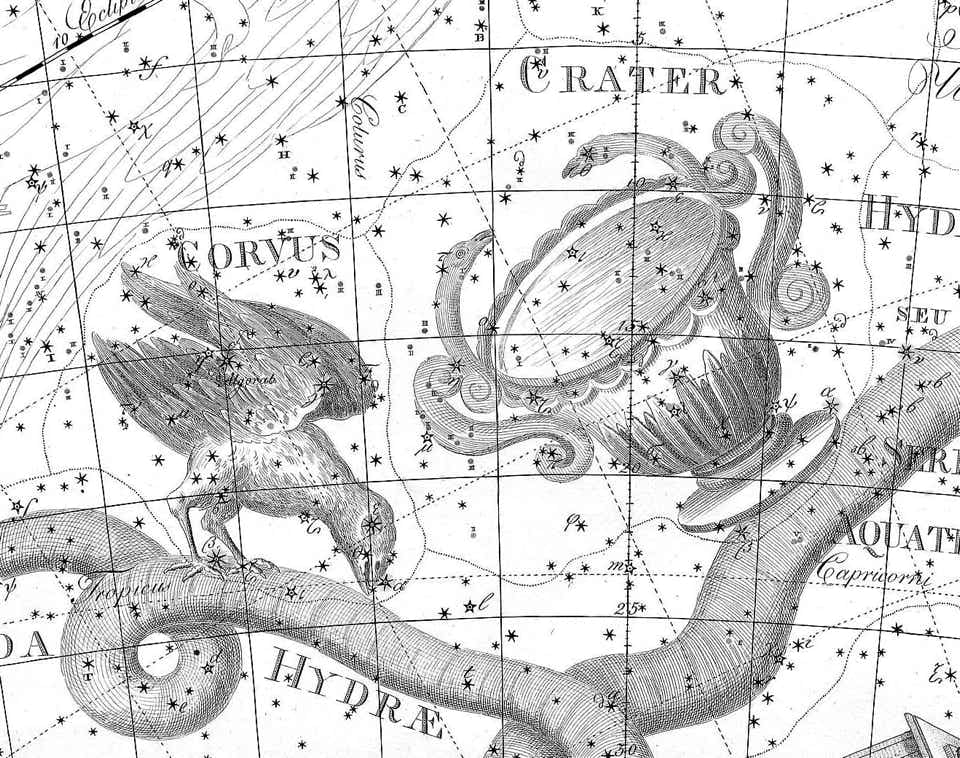
and

Genitives: Corvi; Crateris
Abbreviations: Crv; Crt
Size rankings: 70th; 53rd
Origin: Two of the 48 Greek constellations listed by Ptolemy in the Almagest
Greek names: Κόραξ (Korax); Κρατήρ (Krater)
These two adjacent constellations are linked in a moral tale that goes back at least to the time of Eratosthenes in the third century BC. As told by Ovid in his Fasti, Apollo was about to make a sacrifice to Zeus and sent the crow to fetch water from a running spring. The crow flew off with a bowl in its claws until it came to a fig tree laden with unripe fruit. Ignoring its orders, the crow waited several days for the fruit to ripen, by which time Apollo had been forced to find a source of water for himself.
After eating its fill of the delicious fruit, the crow looked around for an alibi. He picked up a water-snake in his claws and returned with it to Apollo, blaming the serpent for blocking the spring. But Apollo, one of whose skills was the art of prophecy, saw through the lie and condemned the crow to a life of thirst – which is perhaps one explanation for the rasping call of the crow. In memorial of this incident Apollo put the crow, the cup, and the water-snake together in the sky.
Corvus and Crater, two adjacent constellations on the back of Hydra, shown on Chart XIX of the Uranographia of Johann Bode (1801). In ancient Greece, a krater was a bowl or vase used for mixing wine with water, rather than a cup as we know it.
The crow is depicted pecking at the water snake’s coils, as though attempting to move it so that the crow may reach the cup to drink. The cup, usually represented as a magnificent double-handed chalice of the type known in Greece as a krater, is shown tilted towards the crow but tantalizingly just out of the thirsty bird’s reach. The water-snake is the constellation Hydra which, in another legend, doubles as the creature slain by Heracles.
The crow was the sacred bird of Apollo, who changed himself into one to flee from the monster Typhon when that immense creature threatened the gods. In another story, related by Ovid in his Metamorphoses, the crow was once snow-white like a dove, but the bird brought news to Apollo that his love, Coronis, had been unfaithful. Apollo in his anger cursed the crow, turning it forever black.
In Greek, Crater was known as Κρατήρ (Krater) while Corvus was Κόραξ, i.e. Korax. The star we know as Alpha Corvi, named Alchiba, represents the crow’s beak, pecking at the Hydra, while Beta marks its feet, planted firmly on the Hydra’s back. Ptolemy in the Almagest said that these two stars were shared with Hydra, as was Alpha Crateris in the base of the cup, but he listed them only once in his catalogue, under Corvus and Crater respectively and not under Hydra.
The brightest star in Corvus is Gamma Corvi, known as Gienah, marginally brighter than Beta Corvi at magnitude 2.6 (Alpha is only of magnitude 4.0). Its name comes from the Arabic word janāḥ meaning wing. Ptolemy in the Almagest described this star as lying in the ‘advance, right wing’; however, the way the bird is positioned in the sky the more advanced wing is actually the left one (see illustration above) so seemingly Ptolemy, or perhaps a later scribe, transposed left and right. Delta Corvi, called Algorab from the Arabic al-ghurāb, meaning the raven, was placed by Ptolemy in the ‘rear wing’.
According to the Arab star lore expert Danielle Adams of the University of Arizona, the stars β, δ, γ, and ε Corvi formed a group known as the Tent, al-khibā’, representing the campsite of a caravan as it stopped to rest while crossing the desert. From this Arabic word has come the name Alchiba, applied to Alpha Corvi.
In Crater the brightest star is Delta, magnitude 3.6; Alpha is only magnitude 4.1. Hence Corvus and Crater are both constellations in which the star labelled Alpha is not the brightest.
Chinese associations
In the Chinese constellation system, the present-day Beta, Gamma, Delta, and Epsilon Corvi formed Zhen, a wagon or chariot; this was also the name given to the 28th (and final) lunar mansion. Alpha and Eta Corvi, the stars next to two opposite corners of the quadrilateral, represented linchpins holding on the wheels. The star at the centre, Zeta Corvi, was known as Changsha, representing a coffin.
The stars of Crater plus some in Hydra formed a large, spidery figure of 22 stars called Yi, representing the wings of the Red Bird. Yi was also the name given to the 27th lunar mansion. In an alternative interpretation, Yi represented a legendary archer (also known as Houyi), his bow being the adjacent constellation Zhang in present-day Hydra.
© Ian Ridpath. All rights reserved



